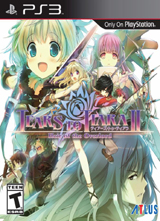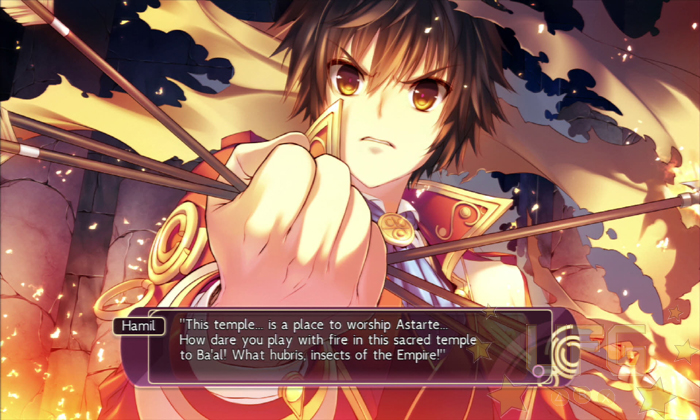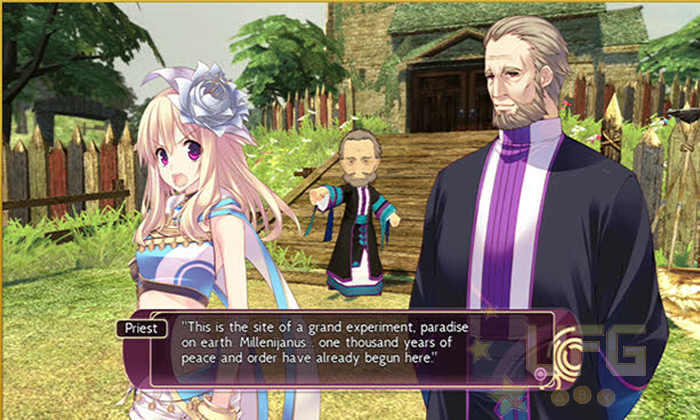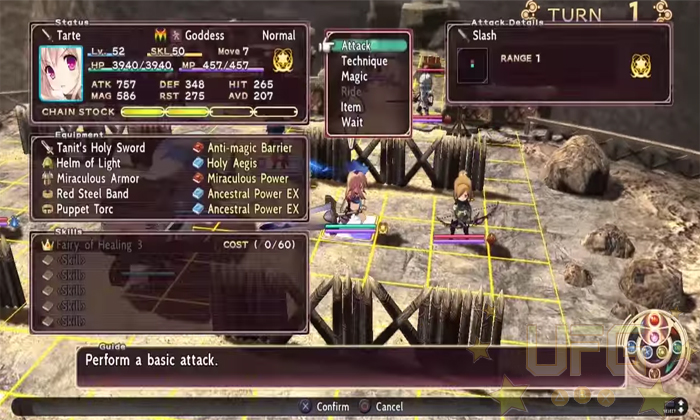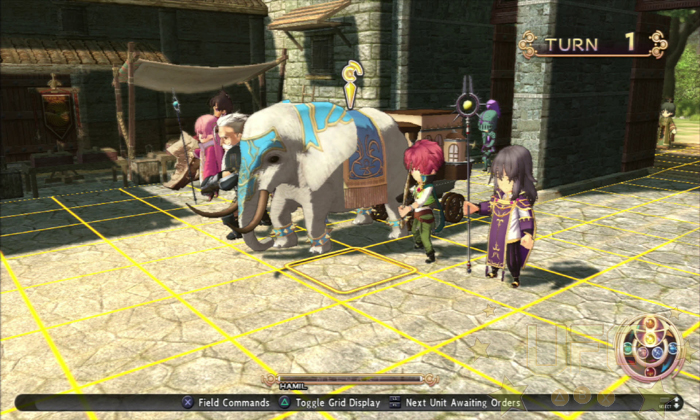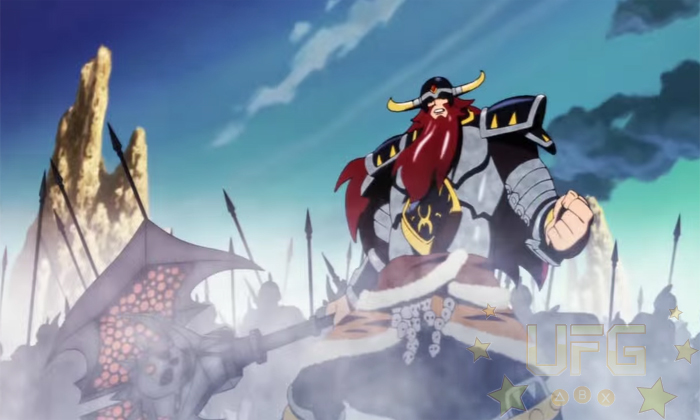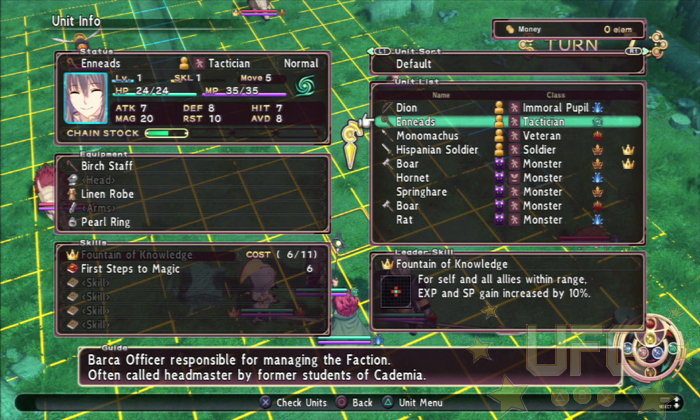Tears to Tiara 2: Heir to the Overlord
Aquaplus games don’t usually make it to North America. Outside of Aquapazza: Aquaplus Dream Match released a year ago, I can’t think of anything that made its way here. With the help of ATLUS though, their tactical (or strategy) based RPG, Tears to Tiara 2: Heir of the Overlord was given a US release. It’s a good thing too because I thoroughly enjoyed me time reviewing this title!
In Tears 2 you follow the story of Hamil, the sole survivor of Hispania’s royal bloodline. Following the murder of his father, head of the Barca house and governor of the province, the region is conquered by the Divine Empire. After seven long years of oppression, Hamil starts an uprising against the empire to help Hispania regain its independence.
Though seen as a naive boy, he is actually a great tactician who is well suited to lead his people to victory. Of course, that will be easier said than done; the plot is full of twists and surprises from the very beginning. One thing I noted early on was the way the narrative was being told. There is a mix of beautifully drawn 2D stills with animated/cartoony cutscenes (using the in-game graphics). The stills depict who’s currently speaking while the action is shown in-game. It’s like a visual novel of sorts, told in long stretches between battles. Fans of the original game, or JRPG’s in general, should be happy to know that the voice acting features the original Japanese dub. This is cool as it allows us to play a more “authentic” version of the game. At the same time, the scenes can be quite long, even reaching an hour in length (depending on how fast you read or if you skip through them). This is due to having to read large amounts of dialog as the story unfolds. If you just want to play the game and don’t care about what’s going on, you can just hold down the square button to fast forward the scene. If you do want to see the whole story but get a little antsy and skip too fast you’re not forced to see the whole scene again as hitting the L1 and R1 buttons will flip through what you missed.
If you can get over how long these in between scenes are, you discover a lot to like. For instance, the game starts off in what seems to be a generic fashion. You know, the one where the protagonist is seen in battle with his or her endgame abilities just laying waste to everything on the battlefield. What’s interesting is that this isn’t a late battle at all. This is the start of the Hispania’s rebellion. Aquaplus does a great job of explaining why you’re so powerful, who the supporting characters are, and untimely what is going on. Strong narrative beats dealing with strong themes like sexuality and slavery are explored without bogging the plot down; some may feel uncomfortable yet can rely on certain characters to add comic relief, making the story a little less serious at times.
Now that we got the story out of the way, let’s talk gameplay. Tears 2 is a turn-based strategy RPG similar to Final Fantasy Tactics – a genre that doesn’t offer up games every day, so naturally it peek my interest. Each stage is started with a screen that shows you the conditions for victory, defeat, and a bonus that can increase your grade when completed. Before you actually get to the fighting, you’ll have to pick who you’ll deploy (more on that layer). During the battle characters are granted XP and SP for performing most actions. XP allows your character to level up and increase their stats while SP is used to increase your skill level to learn new techniques and magic. Basic RPG stuff right? Well, the combat can be kind of confusing. Each character has a class (or rather a vague description of their personality) and an element he or she is associated with. Calling Hamil “Barca head” describes who he is and not what he can do on the battlefield for instance. There are symbols next a characters’ name that displays what weapons they use. While it isn’t like saying Mage or Rogue, it does help in figuring out their roles.
Once you’ve deciphered who does what, you can then start to figure out the best ways to use them. The first thing to remember is that each person has an element tied to them, which in turn falls under two sets. The basic fire, wind, earth and water are augmented by holy, astral, and dark elements. They all follow a rock, paper, scissors rule set; water beats fire, fire beats wind, wind beats earth and so on. On top of this is an element cycle at the bottom right hand corner of the screen that lets you know which element to focus on. Whichever element is in the top spot receives a damage bonus for that turn. So, using water against a fire enemy while it is in the top spot will net loads of damage.
Adding to this are the weapon types (melee or range) which have their own set of rules when interacting with an enemy. A melee character will counter attack if attacked by another melee character. Range characters, on the other hand, can’t counter attack or be counter attacked by other characters. There are exceptions to this rule when using magic or special techniques If a melee character uses a magic spell on another melee character they won’t be countered. Remember when I said you could place party members on the battlefield before the fight starts? Well, knowing this information will help you decided where they should go. During this time you’ll also need to pick a leader to well…lead during this particular battle. Each character has a leader skill that buffs the group, increases XP or gold earned and more. Having the right leader skills can really turn the tides to your favor or allow you to upgrade quicker in the battle or even increase XP or gold earned.
The battlefield itself can be dangerous with hidden traps, magic seals and other obstacles strewn around. All of these things are layered together in such a way to offer a decent amount of depth, requiring players to maintain a certain level of awareness; you shouldn’t just go in swinging. More than likely at some point you will make a mistake, resulting in the loss of a character or something equally grave. That doesn’t have to be the end of the battle though thanks to a limited rewind feature. The rewind allows you to go back to the beginning of any turn a few times in each battle. While a sort of safety net, they don’t change the outcome of a selected move. Meaning, if you attack and miss an enemy rewinding and doing it again won’t change the outcome. It’s only useful if you do something different after resetting the turn.
So far I’ve been talking about the battle mechanics, but there is much more to the game than just fighting. There’s the stuff you can do, before going to fight as well. Hamil’s base of operations houses different shops, allowing you to buy gear and helpful items. There’s even rudimentary crafting – it’s more like buying a new item and using different forms of currency then actually making something new. While at the base you can also look at your party and equip them with different skills and gear. For those of you that may have issues with what stats to build up for each member, there is a recommended option to equip everyone with the best gear available and an “equip all” option that equips everyone with the recommended gear for their character type.
Tears 2 is an extremely deep game, introducing new mechanics and party members even forty hours in. To help with that, every time a new mechanic is introduced there is a tutorial that breaks it down for you. The challenges are real and it feels good to conquer a tough enemy. That said, there are some problems worth noting. More likely than not (unless you’re playing on easy) you’re going to have to revisit some places. Being a JRPG grinding is still something you have to do and there are no side quests to help get more XP and gold. These things are needed as you continue the story; the upgraded gear in the shops and crafting end up costing you quite a lot of money and the battles do get noticeably harder. There isn’t a ridiculous difficulty spike at any one point and using the “grilled apple” item does speeds things up. Still, the game does make grinding somewhat mandatory. Waiting more than 15 minutes in scenes before you get to the next battle is too long and all of the dialog can feel like a chore to read through. And with over 80+ hours of game here, anytime out of battle can seem to take forever.
On the other hand, the game is fun to play. The music is incredible; I’ve personally always been a fan of the music in JRPGs and Tears 2 doesn’t disappoint. The cartoonish art style is charming in its own right and the 2D anime stills are great looking. After completing the story, there is an extra scenario comprised of a 50 floor challenge dungeon. Basically, there is a lot here to keep fans satisfied for a long time!
Gameplay:
8
The gameplay itself is great…when you aren’t waiting for a long cutscene to end.
Graphics:
9
I love the 2D anime style artwork.
Sound:
8
I am a fan of the orchestra music and the soothing tunes. It’s a game I can turn on just for the soundtrack alone.
Replay Value:
8
If you completed the main story than the extra scenario should keep you busy.
Final Score:
8.3
